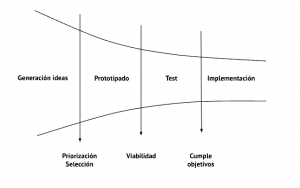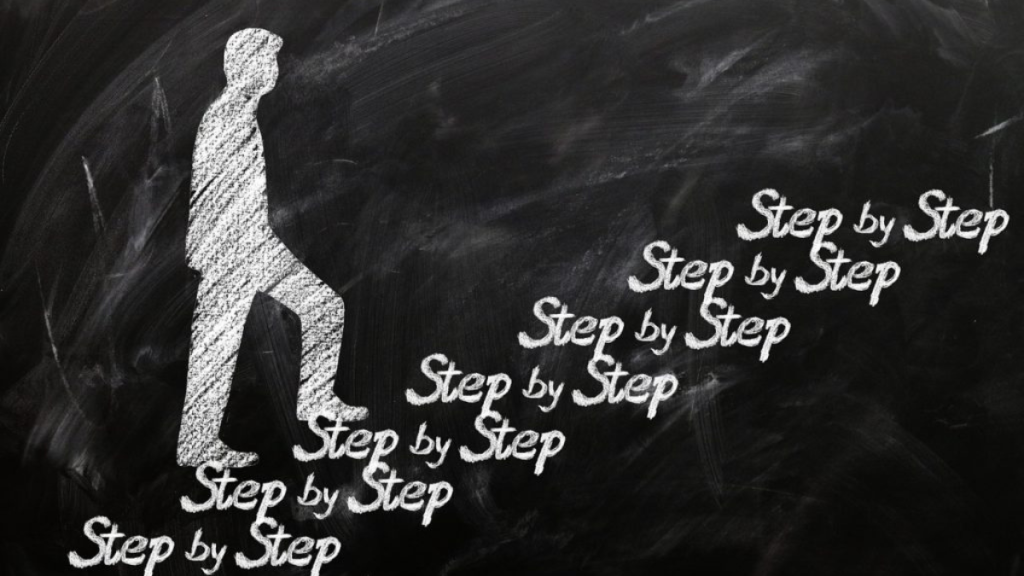SYSTEMIC INNOVATION PROCESS
Accelerate your business with these expert tips on "Systemic innovation process". Analyse and discover this TIP!
There is no innovation without process, methodologies and metrics. For the dynamics of innovation to be constant in our company, it is necessary to design and establish the functions and the process that guarantees a permanent execution of the search for ideas, their prototyping and validation and the final decision making based on indicators oriented towards the defined objectives.
This process is called the "funnel" or innovation funnel in which we identify the phases, filters and indicators with which we will manage our innovation projects.
An example of a funnel could be this one:

Phase 1 - IDEA GENERATION
At the beginning of the funnel is our portfolio of ideas which must contain as many proposals as possible covering all areas of the strategy you have defined in your company; a balanced portfolio of innovation ideas core, It is the most creative phase of the process!!!
Filter 1 - prioritisation and selection
Phase 2 - PROTOTYPING
At this point the idea takes shape, becomes a project and define the operations, business sponsors and the way in which it will be carried out in order to test it in a test environment.
Filter 2 - feasibility of the project
Phase 3 - PILOT
A first version is tested in a controlled environment (laboratory) and iterative work is carried out on it by introducing successive improvements until it has been fine-tuned.
Filter 3 - meets objectives
Phase 3 - IMPLEMENTATION
Innovation is implemented in the real environment, replicated and scaled to generate real business impact.
To ensure the quality of the whole process, should be used non-economic metrics and internal metrics, for the early stages and hard financial indicators only when the initiative is ready to pilot.
These initiatives are almost always small-scale and therefore require little funding. Even so, it is essential to have a small pool of freely available budget to enable the necessary tests to be carried out without the obligation to obtain a return in return.
FINALLY, THIS WHOLE PROCESS MUST BE LED AND EXECUTED BY A PERSON WHO, AS THE PERSON RESPONSIBLE FOR INNOVATION IN THE COMPANY, IS IN CHARGE OF:
- Leading and managing a broad portfolio of innovation to boost the business areas in a transversal manner.
- Identify, test and validate new strategic opportunities through innovation management methodologies.
- Leading exploration activities to analyse business opportunities in the innovation ecosystem.
- Leading the innovation process between stakeholders in the organisation; business areas, board members and executive levels.
- Measuring the impact of innovation with KPIs and OKR.
HERE ARE SOME TIPS ON HOW AN ENTREPRENEUR CAN CREATE A SYSTEMIC INNOVATION PROCESS IN HIS OR HER COMPANY:
- Define a clear vision: Establish a clear vision of what you want to achieve through innovation in your company. Define the objectives and goals you want to achieve and how innovation can help you achieve them.
- Fostering a culture of innovation: Create an environment that fosters creativity, collaboration and innovative thinking. Encourage your team to come up with new ideas and solutions, and celebrate the successes and learnings from innovation.
- Establish a structured process: Design a structured process to guide the flow of ideas from idea generation to implementation. Define the key phases of the process, such as idea generation, prototyping, validation and implementation, and establish the filters and evaluation criteria for progressing through each stage.
- Involve the whole team: Innovation should not be the sole responsibility of a small group. Involve your entire team in the innovation process, allowing them to contribute ideas and participate in the different stages of the process.
- Establish monitoring metrics: Define key performance indicators (KPIs) to evaluate the success of your innovation initiatives. These metrics can include impact on financial results, customer satisfaction, product development time, among others. Use these metrics to make informed decisions and adjust your innovation approach.
- Promote external collaboration: Explore collaboration opportunities with external partners, such as startups, universities or industry experts. These collaborations can bring new perspectives, expertise and access to additional resources to drive innovation in your company.
- Continuous learning and adaptation: Innovation is an iterative process. Learn from successes and failures, and use that knowledge to continuously improve your innovation initiatives. Be open to change and adapt your approach as needs and opportunities arise.
Remember that every company is unique, so it is important to adapt these tips to your specific context. The key is to build an innovation process that aligns with your company's goals and culture, encouraging creativity and collaboration in search of disruptive solutions and constant improvement.
LA ARTIFICIAL INTELLIGENCE (SEE+ TIP) CAN HELP YOU IN THE CREATION OF A SYSTEMIC INNOVATION PROCESS IN A NEW COMPANY IN THE FOLLOWING WAYS:
- Idea generation: You can use artificial intelligence to generate creative and novel ideas that drive innovation in your business. Provide information about your industry, market and specific challenges, and artificial intelligence can offer different approaches and solutions for you to consider.
- Process design: Artificial intelligence can help you design a structured innovation process tailored to your company's needs. You can ask for recommendations on key phases, idea selection methods, evaluation criteria and implementation mechanisms. Artificial intelligence can also help you identify best practices used in other organisations.
- Data analysis: Data-driven innovation is crucial for the success of any innovation process. You can use artificial intelligence to analyse relevant data, such as market information, industry trends, customer feedback and more. This will allow you to make informed, data-backed decisions in the innovation process.
- Feasibility assessment: Before investing resources in an innovation idea, it is important to assess its feasibility. Artificial intelligence can help you analyse the technical, economic and strategic aspects of an idea, as well as identify potential obstacles or associated risks. This will allow you to make more informed decisions about which ideas to prioritise.
- Continuous improvement: Artificial intelligence can be used as a constant learning tool in the continuous improvement of your innovation process. You can share the results and performance of your innovation initiatives with artificial intelligence to get suggestions and recommendations on how to optimise and refine your approach.
Remember that artificial intelligence is a language-based tool and its responses are generated based on the data it has been trained on. It is always important to complement the information and ideas provided by artificial intelligence with human knowledge and experience, as well as with a critical assessment of the feasibility and appropriateness of proposed solutions.
APPLY THIS TIP TO YOUR PROJECT
CASE STUDY OF THE SYSTEMIC INNOVATION PROCESS
Company: ABC Tech, a software development company.
PHASE 1 - IDEA GENERATION
- Brainstorming with the development team to identify possible areas of innovation in the field of mobile applications.
- Ideas such as an augmented reality application for the tourism sector and an online medical appointment management platform are generated.
FILTER 1 - PRIORITISATION AND SELECTION:
- An analysis of the feasibility and potential of each idea is carried out.
- It is decided to prioritise the idea of a medical appointment management platform due to the growing demand in the healthcare sector and the associated business opportunity.
PHASE 2 - PROTOTYPING
- - A multidisciplinary team is formed to develop the prototype of the medical appointment management platform.
- - Operational aspects such as user interface, appointment booking flow and integration with clinic management systems are defined.
FILTER 2 - PROJECT FEASIBILITY
- The technical feasibility and resources needed to carry out the project are assessed.
- Feasibility is confirmed and we proceed to the next phase.
PHASE 3 - PILOT
- A pilot test of the platform is carried out in a local health clinic.
- Comments are collected and adjustments are made based on feedback from users and clinic staff.
FILTER 3 - MEETS OBJECTIVES
- It evaluates whether the platform meets the stated objectives, such as efficiency in appointment management, improvement in patient experience and impact on clinic productivity.
- The platform exceeds expectations and is considered ready for larger scale implementation.
PHASE 4 - IMPLEMENTATION
- The medical appointment management platform is implemented in multiple clinics and a marketing plan is implemented to promote its use among patients.
- Performance is monitored and additional adjustments are made as necessary.
This example illustrates how the systemic innovation process is applied in the development and launch of a medical appointment management platform. Each phase of the innovation funnel focuses on the generation of ideas, the selection of viable projects and their successful implementation in the market.
QUIZ
- 💻 PRACTICE with an expert in the next practical webinar.
- 🔎 CONSULT more related TIPs with this same theme.
- 📖 AMPLIA your knowledge by downloading this EBOOK.
THINK ABOUT YOU
- 🚀 IMPULSA your company in the next acceleration programme, ¡book your place now!
- 🥁 PRACTICE with your project in this practical webinar, ¡apply for your place!
- 🌐 CONTACT with other entrepreneurs and companies, ¡register and take part in the next Networking!
THINK ABOUT HELPING OTHERS
- 🤝COLLABORATE as a volunteer: expert, mentor, inverter, awarding, Spreading the word, challenging, innovating, creating a TIP...
- 💬 RECOMMENDS this programme to reach out to more entrepreneurs by Google.
- 👉 SHARE your learning!
- 📲 SEND this TIP 👇
Rate this TIP!
Click on the stars to rate
Rating "1" - Average " - Average5"
No votes yet, be the first to vote!
We are sorry you did not find it useful.
Help us improve this TIP!
Leave us a comment and tell us how you would improve this TIP










